William Lee Hankey
The Louvain Basin, Boulogne
20.25 X 24 in (51.44 X 60.96 cm)
Oil on canvas
Private collection
William Lee Hankey (1869–1952) RWS, RI, ROI, RE, NS was a British painter and book illustrator.[2] He specialised in landscapes, character studies and portraits of pastoral life, particularly in studies of mothers with young children such as "We’ve Been in the Meadows All Day".
He was born in Chester and worked as a designer after leaving school. He studied art in the evenings at the Chester School of Art, then at the Royal College of Art. Later in Paris he became influenced by the work of Jules Bastien-Lepage, who also favoured rustic scenes depicted in a realistic but sentimental style. He first exhibited at the Royal Academy in 1896 and was President of the London Sketch Club from 1902 to 1904. He stayed in France in the early 1900s, painting many of his works in Brittany and Normandy, where he depicted a peasant lifestyle which was already disappearing in England. From 1904 until well after World War I he maintained a studio at the Etaples art colony.
It was Hankey's black and white and coloured etchings of the people of Étaples, several developed from his paintings, which gained him a reputation as 'one of the most gifted of the figurative printmakers working in original drypoint during the first thirty years of the 20th century'. One that is particularly striking for its stylistic presentation was "The Refugees", his contribution to raising awareness of the consequences for ordinary people of the German invasion of France and Belgium in 1914. He went on to serve with the Artists' Rifles from 1915 to 1918.
In Britain he had been associated with the Newlyn School, a group of English artists based in the titular village in Cornwall who were themselves influenced by the romantic poets such as Wordsworth and Keats.
More on William Lee Hankey
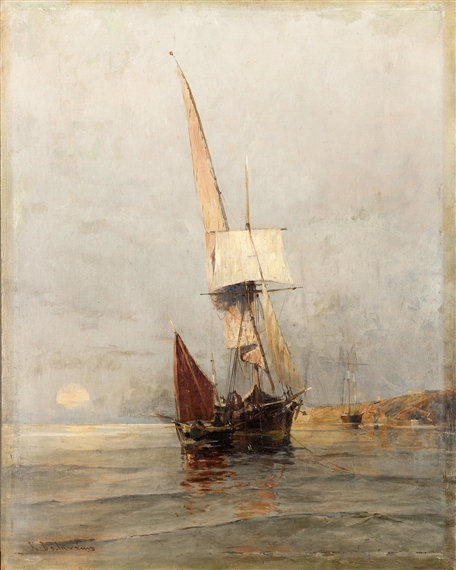
Konstantinos Volanakis, (1837–1907)
Sailing boats in the sunrise
16.14 X 12.99 in (41 X 33 cm)
Oil on panel
Private collection
Vasileios Chatzis, Patra 1870 - 1915
In calm waters
15.16 X 30.12 in (38.5 X 76.5 cm)
oil on canvas
Creation Date: 1997
Vasileios Chatzis, (Patra 1870 - 1915). After spending his childhood in Patra, he studied at Athens School of Fine Arts (1886-1893) under professors Nikiphoros Lytras and Konstantinos Volanakis. He began to exhibit in 1899 when he participated in the Exhibition of Athens and then presented his works in group exhibitions in Athens and Alexandria.
During the Balkan Wars of 1912-1913, he embarked, by government order, on warships and captured scenes of the actions carried out by the Greek fleet. Known mainly as a painter of seascapes, he was also dealt with landscapes and the depiction of scenes from lives of farmers and fishermen, sometimes appearing to be an adherent of academicism or of open air approaches.More on Vasileios Chatzis
Konstantinos Volanakis (1837–1907)
Harbour scene
27.36 X 21.65 in (69.5 X 55 cm)
Oil on canvas
Private collection
Konstantinos Volanakis (1837, Heraklion - 29 June 1907, Piraeus) was a Greek painter who became known as the "father of Greek seascape painting". He completed his basic education on Syros in 1856. Afterward, urged on by his brothers, he went to Trieste and became an accountant for a family of Greek merchants who were related to his family by marriage. While there, he made sketches of ships and harbors in his account books. Rather than dismiss him, the family recognized his artistic talent, and made arrangements for him to study at the Academy of Fine Arts, Munich, under Karl von Piloty, joining a group of Greek students. His instructors discouraged any sort of landscape painting, because it was "in decline", so he concentrated on portraits.
His break came in 1869, three years after the Battle of Lissa (see Blow), when Emperor Franz Joseph held a drawing competition to memorialize the event. Volanakis won the contest, receiving 1000 gold Florins and free travel cruises with the Austrian navy for three years. He took full advantage of this, producing numerous canvases and sketches. He married in 1874. Nine years later, despite warnings from Gyzis that it would ruin his career, he returned to Greece and settled in Piraeus, where his family had a pottery factory, citing pressure from his wife, whose health was suffering from the cold winters in Germany.
From then until 1903, he was a teacher at the Athens School of Fine Arts. He also operated his own private school. In 1889, he was awarded the Silver Cross of the Order of the Redeemer. He was, however, very poor in his later years, due to his very large family and declining interest in his art. In an effort to increase his income, he reversed the usual method of painting first, then framing, by working with a group of framers who would make luxurious carved frames first, then creating paintings to fit them. More on Konstantinos Volanakis
Konstantinos Volanakis (1837–1907)
Naval battle at Lissa, c. Date 1869
Oil on canvas
283 × 169 cm (111.4 × 66.5 in)
National Gallery - Alexandros Soutsos Museum
The Battle of Lissa took place on 20 July 1866 in the Adriatic Sea near the Dalmatian island of Lissa and was a decisive victory for an outnumbered Austrian Empire force over a numerically superior Italian force. It was the first major sea battle between ironclads and one of the last to involve deliberate ramming.
The Italian navy fired roughly 1450 shots during the engagement, but failed to do any serious damage to any Austrian ship while losing two battleships. One of the main reasons for this poor performance was internal rivalry between the Italian fleet commanders. The engagement was made up of several small battles: the main battle was between seven Austrian and four Italian ironclads and showed the ability of Austrian commander Tegetthoff to divide his more numerous opponents and then destroy the isolated ironclads. More on The Battle of Lissa
Spyros Vassiliou (1903-1985)
The red boat, c. 1970
20.87 X 28.74 in (53 X 73 cm)
Acrylic on canvas
Private collection
Spyros Vassiliou (1903-1985) was a Greek painter, printmaker, illustrator, and stage designer. He became widely recognized for his work starting in the 1930s, when he received the Benaki Prize from the Athens Academy. The recipient of a Guggenheim Prize for Greece (in 1960), Spyros Vassiliou's works have been exhibited in galleries throughout Europe, in the United States, and Canada. More on Spyros Vassiliou
Jan Abrahamsz. Beerstraaten (Amsterdam 1622-1666)
A Mediterranean ‘capriccio’ harbour with figures conversing on a quay
and a Dutch three-master mooring beyond, c. 1665
Oil on canvas
75.5 x 65.5 cm.
Private collection
Jan Abrahamsz Beerstraaten (1622 in Amsterdam – July 1666 in Amsterdam) was a Dutch painter of marine art and landscapes, particularly of events of the First Anglo-Dutch War and Dutch-Swedish War.
There is some confusion about the identity of four landscape painters named Beerstraaten; Johannes, this Jan Abrahamsz, Abraham, and Anthonie. Jan Abrahamsz, painter, married in Amsterdam on 30 August 1642. From this marriage eleven children were born, and when he married a second time in 1665, a daughter was born. Currently, The RKD records Johannes as the same person, and Abraham Beerstraaten is considered to be his oldest son.
Anthonie Beerstraaten was related to this painter. The RKD has registered two paintings signed Anthonie van Beerstraten: one is a view of a southern seaport from 1664 (currently location Enkhuizen) and the other a view of a church in Aarlanderveen in the former city hall of Alphen aan den Rijn. Based on these two paintings C. Hofstede de Groot an early Dutch art historian, classified paintings signed A. Beerstraaten as by Anthonie if they were a poorer grade than ones already attributed to Abraham.
More on Jan Abrahamsz Beerstraaten
Fausto Pratella, (Italian, Napels 1888-1946 Napels)
Fishermen in the bay of Naples
Oil painting on canvas
51.2 x 59.1 in. (130 x 150 cm.)
Private collection
Fausto Pratella was born in Naples on October 10, 1888. Son of Attilio Pratella.
After he took courses at the Academy in Naples, his father's teachings and advice were of great help to him.
The first painting he exhibited in official exhibitions was "Sunset," which was purchased by the Naples City Hall in 1909.
He then exhibited assiduously at regional and national Neapolitan exhibitions, sometimes at the Venetian Internationals, and at the First Quadrennial in Rome.
One of his "Landscapes" is in the "Paolo and Adele Giannoni" Gallery in Novara, and many others are placed in private collections.
Henri Logelain, (Belgian, Ixelles 1889-1968 Ixelles)
Antwerp harbour
Oil painting on canvas
27.6 x 33.9 in. (70 x 86 cm.)
Private collection
Henri Logelain studied at the Academy of Fine Arts in Brussels and in Rome at the Academia Belgica . He exhibited his works from the year 1911. He taught at the Academy of Fine Arts in Louvain as well as at the School of Decorative Arts in Vilvoorde . Logelain was a member of the free workshop L'Effort where he met Auguste Oleffe , of the Royal Belgian Society of Watercolourists and of the Belgian Society of Painters of the Sea .
Originally a watercolourist , his favorite subjects are landscapes, still lifes, seascapes, urban views and portraits. A neo-impressionist painter , he experienced a Fauve period around 1910. He traveled to the Belgian Congo in 1938 and made many portraits of Congolese there.
More on Henri Logelain
Maurice Blieck, (Belgian, Laken 1876-1922 Brussels)
Bridge at the river with steamer
Oil painting on canvas
15.4 x 20.9 in. (39 x 53 cm.)
Private collection
Maurice Emile Blieck 'Maurice Blieck': A Belgian painter and etcher of landscapes, marine views and portraits, Maurice Emile Blieck first studied art at the Academy of Brussels. In 1896 he completed his education in both Paris and London and began formally exhibiting his art in these cities at this time. Establishing his reputation first as a painter, Maurice Blieck began etching around 1905.
During the early twentieth century Maurice Blieck lived and worked in both Belgium and France. Around 1912 he worked upon a series of etchings detailing the Flemish town of Ypres. Ypres, Rue de Nazareth hails from this set. Several years later this town became a center for some of the heaviest fighting and destruction of the First World War. As most of the city was destroyed by four years of artillery fire this fine etching thus represents both a valuable historical and artistic record.
More on Maurice Blieck

Jan Abrahamsz, Beerstraaten (1622–1666)
The battle of Terheide, 10 august 1653, c. between 1653 and 1666
Oil on canvas
Height: 176 cm (69.3 in). Width: 281.5 cm (110.8 in).
Rijksmuseum Amsterdam
The Battle of Scheveningen was the final naval battle of the First Anglo-Dutch War. It took place on 31 July 1653 between the fleets of the Commonwealth of England and the United Provinces, and had no clear victory. More

Nicholas Pocock
BRISTOL 1740 - 1821 MAIDENHEAD
THE BRITISH FLEET AT SEA - THE NEARER SHIP FLYING THE ROYAL STANDARD
Watercolour over pencil
110 by 163 mm
Pocock was born in Bristol and spent his early life at sea. In circa 1778 he settled in London and devoted himself to painting. He was successful and was patronised by the Navy Board, Admiral Lord Hood, Lord Bridport, Lord Gambier, Lord Barham and many other great navel men.
Circle of Abraham Storck (Amsterdam 1644-1708)
A parade of Dutch ships in choppy waters
oil on canvas
48.4 x 63.9 cm
Abraham Storck (1644–1708)
The 'Royal Prince' and other Vessels at the Four Days Battle, in the Second Anglo-Dutch war, 1–4 June 1666, circa 1670
Oil on canvas
78.5 × 110.5 cm (30.9 × 43.5 in)
National Maritime Museum
The Second Anglo-Dutch War (4 March 1665 – 31 July 1667), fought between England and the United Provinces, was part of a series of four Anglo-Dutch Wars fought between the English (later British) and the Dutch in the 17th and 18th centuries for control over the seas and trade routes, where England tried to end the Dutch domination of world trade. After initial English successes, the war ended in a decisive Dutch victory. English and French resentment would soon lead to renewed warfare. More on The Second Anglo-Dutch War
Abraham Storck (or Sturckenburch) (bapt. 17 April 1644 in Amsterdam – buried 8 April 1708), was a Dutch painter, who enjoyed a reputation for his marine paintings, topographical views and Italianate harbour scenes. Storck was also an outstanding draughtsman
Circa 1666 Storck established his workshop producing naval, harbor scenes as well as landscape paintings and city scapes. In 1670 he traveled with his brother Jacob and worked in Germany. In 1694, at age 49, he married the widow Neeltje Pieters van Meyservelt. At the end of his life he lived on Kattenburg near the harbour.
Storck produced fantastical views of Mediterranean ports, which place merchant shipping amidst architectural ruins, depicted in the crystal-clear colours of Italian art of the period. This type of scene anticipated the popular 18th-century Italian capriccio. He depicted ships' rigging and technical details with considerable accuracy, which likely shows the influence of the van de Veldes. His Dutch harbour and river views often include recreational and ceremonial aspects of shipping. He paid particular attention to the display of pleasure yachts, ceremonial gatherings of ships, the passengers and bystanders.
Storck painted some winter scenes, which are inspired by the example of Jan Abrahamsz Beerstraaten and his son Anthonie Beerstraaten, a selfportrait, and some allegories.
More on Abraham Storck
.jpg)
Abraham Storck (1644–1708)
The frigate Pieter and Paul on the IJ., c. 1698-1700
Oil on canvas
53 × 63 cm (20.9 × 24.8 in)
Amsterdam Museum
In 1703 Russia’s military success against Turkey allowed Peter I to claim a lucrative trade route to Europe – via the Baltic Sea. But to protect the Baltic land he needed a strong Navy. During his Grand Embassy Peter studied the art of shipbuilding. In Amsterdam “Peter and Paul” frigate was built and launched specially for Peter so he could watch the full building cycle. Peter received a certificate that stated that Peter Mikhailov “studied the art of shipbuilding to the extent that we are knowledgeable in it”. More on The frigate Pieter and Paul
James Hamilton MacKenzie ARSA RSW ARE (British, 1875-1926)
Harbour Scene, Possibly Nantes
Oil on canvas
45 x 60 cm. (17 11/16 x 23 5/8 in.)
Private collection
James Hamilton Mackenzie (1875 - 1926) was born in Glasgow and studied at the Glasgow School of Art where he won a scholarship that took him to Florence and Tuscany. He was a long time member of Glasgow Art Club. During the First World War he served in East Africa. His drawings and paintings are featured in The Studio's special war edition of 1918.
He worked abroad during his career notably in Belgium as well as Italy. He was fluent in oil, watercolours, pastels and as an etcher. His Scottish paintings are mostly of landscapes but also include fishing villages.
His career was ended tragically in a fatal accident on a train near Bathgate when he was only 51. He was elected to the Royal Scottish Society of Painters in Watercolour, RSW, in 1910, and an Associate of the RSA in 1923. More on James Hamilton MacKenzie
USS CONSTELLATION
Montague Dawson RMSA, FRSA (1890–1973)
22 X 31 in (55.88 X 78.74 cm)
Color Lithograph
Private collection
USS Constellation, constructed in 1854, is a sloop-of-war/corvette and the second United States Navy ship to carry the name. According to the U.S. Naval Registry the original frigate was disassembled on 25 June 1853 in Gosport Navy Yard in Norfolk, Virginia, and the sloop-of-war/corvette was constructed in the same yard using material salvaged from the earlier ship. Constellation is the last sail-only warship designed and built by the Navy. Despite being a single-gundeck "sloop," she is actually larger than her frigate namesake, and more powerfully armed with fewer but much more potent shell-firing guns.
The sloop was launched on 26 August 1854 and commissioned on 28 July 1855 with Captain Charles H. Bell in command. More
Montague Dawson RMSA, FRSA (1890–1973) was a British painter who was renowned as a maritime artist. His most famous paintings depict sailing ships, usually clippers or warships of the 18th and 19th centuries. Montague was the son of a keen yachtsman and the grandson of the marine painter Henry Dawson (1811–1878), born in Chiswick, London. Much of his childhood was spent on Southampton Water where he was able to indulge his interest in the study of ships. For a brief period around 1910 Dawson worked for a commercial art studio in Bedford Row, London, but with the outbreak of the First World War he joined the Royal Navy. Whilst serving with the Navy in Falmouth he met Charles Napier Hemy (1841–1917), who considerably influenced his work. In 1924 Dawson was the official artist for an Expedition to the South Seas by the steam yacht St.George. During the expedition he provided illustrated reports to the Graphic magazine.
After the War, Dawson established himself as a professional marine artist, concentrating on historical subjects and portraits of deep-water sailing ships. During the Second World War, he was employed as a war artist. Dawson exhibited regularly at the Royal Society of Marine Artists, of which he became a member, from 1946 to 1964, and occasionally at the Royal Academy between 1917 and 1936. By the 1930s he was considered one of the greatest living marine artists, whose patrons included two American Presidents, Dwight D Eisenhower and Lyndon B Johnson, as well as the British Royal Family. Also in the 1930s, he moved to Milford-Upon-Sea in Hampshire, living there for many years. Dawson is noted for the strict accuracy in the nautical detail of his paintings which often sell for six figures.
The work of Montague Dawson is represented in the National Maritime Museum, Greenwich and the Royal Naval Museum, Portsmouth. More on Montague Dawson
THE SOUTHERN CROSS
Montague Dawson RMSA, FRSA (1890–1973)
23.88 X 36 in (60.64 X 91.44 cm)
Oil on canvas
Private collection
SS Southern Cross (1886) was a steam-powered sealing vessel that operated primarily in Norway and Newfoundland and Labrador.
She was lost at sea returning from the seal hunt on March 31, 1914, killing all 174 men aboard in the same storm that killed 78 crewmen from the SS Newfoundland, a collective tragedy that became known as the "1914 Newfoundland Sealing Disaster". More on SS Southern Cross
THE GLORIOUS AMERICAN - THE 'CONSTITUTION'
By Montague Dawson RMSA, FRSA (1890–1973)
40 X 49.75 in (101.6 X 126.36 cm)
Oil on canvas
Private collection
USS Constitution is a wooden-hulled, three-masted heavy frigate of the United States Navy, named by President George Washington after the Constitution of the United States of America. Launched in 1797, Constitution was one of six original frigates built in the North End of Boston, Massachusetts, at Edmund Hartt's shipyard. Her first duties with the newly formed U.S. Navy were to provide protection for American merchant shipping during the Quasi-War with France and to defeat the Barbary pirates in the First Barbary War.
Constitution is most famous for her actions during the War of 1812 against the United Kingdom, when she captured numerous merchant ships and defeated five British warships: HMS Guerriere, Java, Pictou, Cyane, and Levant. The battle with Guerriere earned her the nickname of "Old Ironsides" and public adoration that has repeatedly saved her from scrapping. She continued to serve as flagship in the Mediterranean and African squadrons, and circled the world in the 1840s. During the American Civil War, she served as a training ship for the United States Naval Academy. She carried US artwork and industrial displays to the Paris Exposition of 1878. More on USS Constitution
THE 'CUTTY SARK'
Montague Dawson RMSA, FRSA (1890–1973)
20 X 30 in (50.8 X 76.2 cm)
Oil on canvas
Private collection
Cutty Sark is a British clipper ship. Built on the Clyde in 1869 for the Jock Willis Shipping Line, she was one of the last tea clippers to be built and one of the fastest, coming at the end of a long period of design development which halted as sailing ships gave way to steam propulsion.
The opening of the Suez Canal (also in 1869) meant that steam ships now enjoyed a much shorter route to China, so Cutty Sark spent only a few years on the tea trade before turning to the trade in wool from Australia, where she held the record time to Britain for ten years. Improvements in steam technology meant that gradually steamships also came to dominate the longer sailing route to Australia and the ship was sold to the Portuguese company Ferreira and Co. in 1895, and renamed Ferreira. She continued as a cargo ship until purchased by retired sea captain Wilfred Dowman in 1922, who used her as a training ship operating from Falmouth, Cornwall. After his death, Cutty Sark was transferred to the Thames Nautical Training College, Greenhithe in 1938 where she became an auxiliary cadet training ship alongside HMS Worcester. By 1954 she had ceased to be useful as a cadet ship and was transferred to permanent dry dock at Greenwich, London on public display.
Cutty Sark is listed by National Historic Ships as part of the National Historic Fleet (the nautical equivalent of a Grade 1 Listed Building). She is one of only three remaining original composite construction (wooden hull on an iron frame) clipper ships from the nineteenth century in part or whole, the others being the City of Adelaide, which arrived in Port Adelaide, South Australia on 3 February 2014 for preservation, and the beached skeleton of Ambassador of 1869 near Punta Arenas, Chile. More on the Cutty Sark
James Kay RSA RSW (British, 1858-1942)
Launch on the Clyde
Oil on canvas
30 x 45 cm. (11 13/16 x 17 11/16 in.
Private collection
SS River Clyde was a 3,913 GRT British collier built by Russell & Co of Port Glasgow on the Firth of Clyde and completed in March 1905. In the First World War the Admiralty requisitioned her for the Royal Navy and in 1915 she took part in the Gallipoli landings. After the war she was repaired and sold to Spanish owners, with whom she spent a long civilian career trading in the Mediterranean before being scrapped in 1966. More on SS River Clyde
James Kay (22 October 1858 - 26 September 1942) was a Scottish artist notable for his paintings of the landscapes and shipping around the River Clyde. Born on the Isle of Arran, Kay spent much of his working life with a studio in Glasgow and living at Portincaple on Loch Long in Argyll and Bute. He was elected to the Royal Scottish Society of Painters in Watercolour (RSW) in 1906 and to the Royal Scottish Academy in 1938. He had one daughter, artist Violet McNeish Kay. More on James Kay
ANGELO BROMBO (1893-1962, Venice)
Venice Canal
Oil on canvas
15-1/2 in. x 11-1/2 in. (40x30cm)
Private collection
Angelo Brombo (Italian 1893-1962)
Venice
Oil on canvas
11 7/8 x 15 3/4 inches / 30.16 x 40.005 cm;
Private collection
Artist Angelo Brombo (Chioggia 1893 - Venice 1962) born into his profession as a decorator inherited from his family by his father Eugenio, who kept the shop under the arcades in Vena fondamenta in the district of Santa Maria where he worked until 1940. From 1925 to 1929 he taught design at the School of Applied Art in Chioggia. His debut was at an exhibition in 1922 where he participated in Chioggia. From 1927 onward he took part in numerous solo and group exhibitions in Italy and abroad. Among these at the Opera Bevilacqua La Masa, 1930, 31, 32 and an exhibition at the Napoleon hall of the Palazzo Reale in Venice with over fifty works in 1945. In 1944 he moved with his family to Venice where he continued to paint until his death in 1962. More on Angelo Brombo
EDGAR FORKNER (American 1867-1945)
Ships in Marina
Oil on canvas
22 1/4 x 28 1/8 inches / 61.59 x 71.43 cm
Private collection
EDGAR FORKNER (American 1867-1945). Nationally known water-colorist, Edgar Forkner was born in 1867 in Richmond, Indiana. Equally adept at painting floral still-lives and harbor scenes, Forkner exhibited over twenty years in the Hoosier Salon Exhibition wining numerous awards for best watercolor. He received his training at the Art Student League in New York studying with J. Carroll Beckwith, Irving Wiles, William Merritt Chase and Frank Vincent Dumond.
An early member of the “Richmond Group”, Forkner worked with John Bundy and others to help establish the Art Association of Richmond. After a few years in Richmond, he traveled to Chicago where he taught watercolor in Auditorium Tower studios. Later he lived in Seattle, Washington becoming active in the Seattle art colony painting harbor scenes along the Pacific coast.
His works are in the permanent collection of the Richmond Art Museum, Richmond, Indiana; Seattle Art Museum and the Chicago Art Institute. His Hoosier Salon award winner, Old Vase of Flowers, was exhibited in the 1933 Chicago World’s Fair. In appreciate of his artistic contributions, The Seattle Art Museum, held a tribute in memory of Edgar Forkner on July 14, 1945 over the radio. Considered a pioneer painter in two art colonies, Mr. Forkner contributed greatly to the artistic legacy and heritage of American regional art. More on EDGAR FORKNER
GEORGE KENNEDY BRANDRIFF (American 1890-1936)
French Tuna Boats II, c. 1929
Oil on board
5 3/8 x 6 3/8 inches / 13.65 x 16.19 cm
Private collection
George Kennedy Brandriff (American 1890-1936)
French Tuna Boats, c. 1929
Oil on board
5 3/8 x 6 3/8 inches / 13.65 x 16.19 cm
Private collection
George Kennedy Brandriff was born on Feb. 13, 1890 in Millville, NJ. After moving to Orange, CA in 1913, Brandriff worked as a piano salesman. Shortly after his arrival he enrolled at the USC College of Dentistry and in 1918 opened a dental office in Hemet, CA. Without the benefit of formal training, he had been painting all his life. He later had a few art lessons from Anna Hills, Carl Oscar Borg, Jack Wilkinson Smith, and in 1928 abandoned dentistry to devote full-time to art. After building a studio-home in Laguna Beach, Brandriff taught painting (Orrin White was one of his pupils) and served as president of the local art association. His subject matter included beach scenes, marines, mountain landscapes, still lifes, and figures. More on George Kennedy Brandriff
Please visit my other blogs: Art Collector, Mythology, Marine Art, Portrait of a Lady, The Orientalist, Art of the Nude and The Canals of Venice, Middle East Artists, 365 Saints and 365 Days, also visit my Boards on Pinterest
Images are copyright of their respective owners, assignees or others.
Some Images may be subject to copyright
I don't own any of these images - credit is always given when due unless
it is unknown to me. if I post your images without your permission, please tell
me.
I do not sell art, art prints, framed posters or reproductions. Ads are
shown only to compensate the hosting expenses.
If you enjoyed this post, please share with friends and family.
Thank you for visiting my blog and also for liking its posts and pages.
Please note that the content of this post primarily consists of articles
available from Wikipedia or other free sources online.
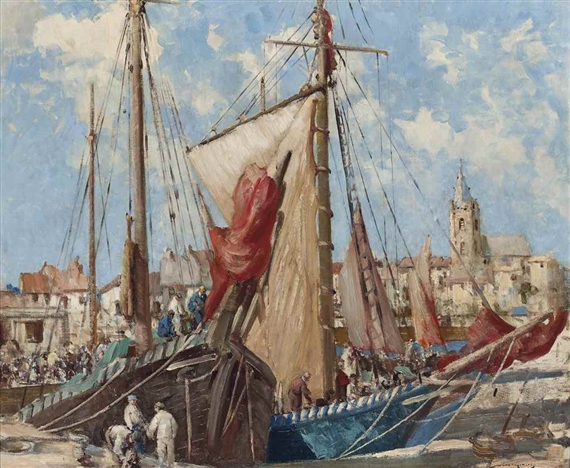

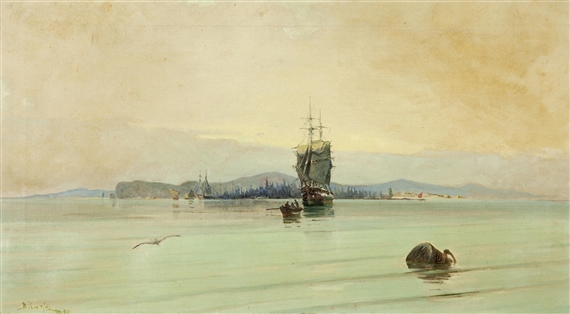
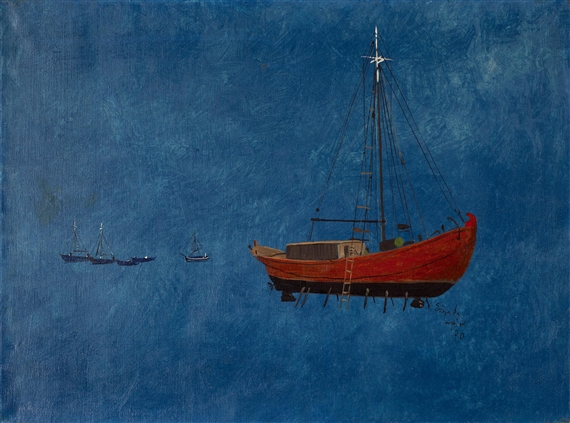



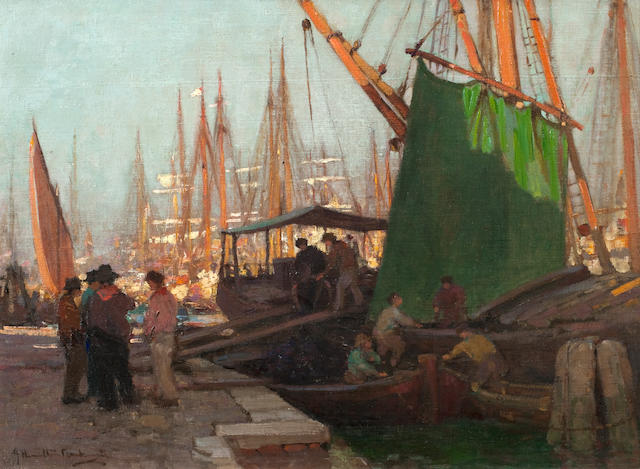
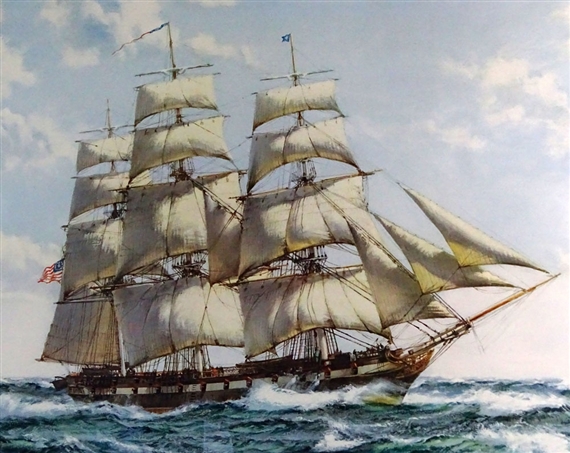
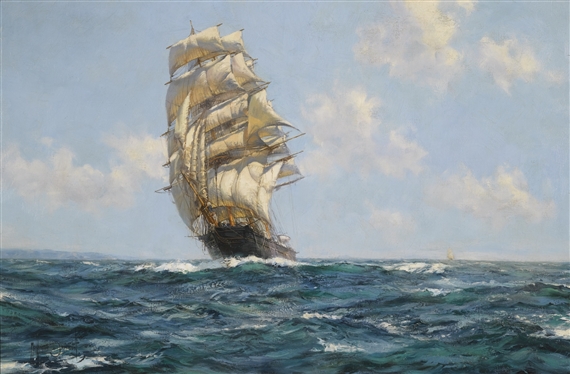
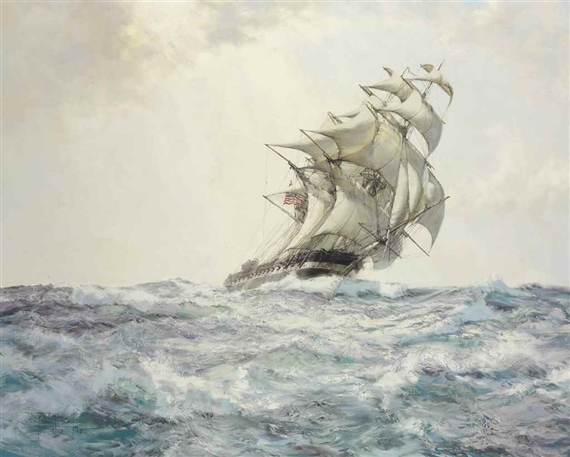
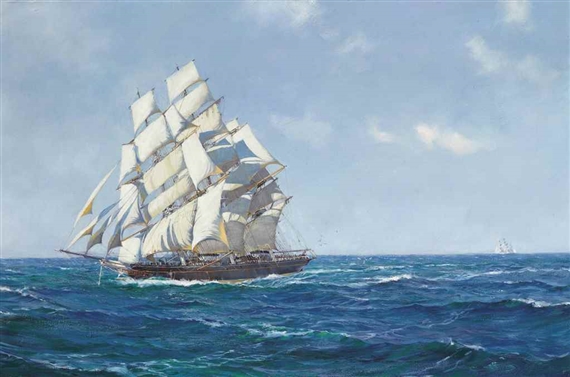
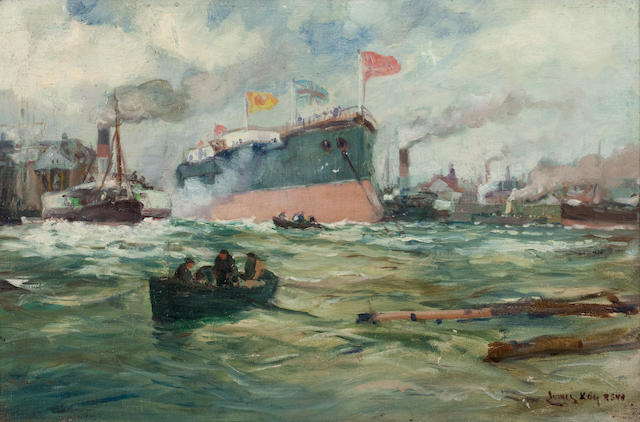










.jpg)





No comments:
Post a Comment